This really sounds like a great summary of what is involved with male pattern baldness, and what some of the causes are. Its a combination of these factors at the heart of it
You are using an out of date browser. It may not display this or other websites correctly.
You should upgrade or use an alternative browser.
You should upgrade or use an alternative browser.
Big New Genome Wide Association Study On Androgenetic Alopecia - Preprint
- Thread starter InBeforeTheCure
- Start date
- Reaction score
- 950
I've combined the GWAS results from Hagenaars et al. (including results of their MAGMA analysis) with this recent meta-analysis by Heilmann-Heimbach et al. Altogether, there are around 115 separate genetic regions identified. I've prioritized genes based on:
1) Average distance from the associated SNPs/indels in the region to the gene.
2) Whether the gene has a known role in hair follicle biology.
3) Co-expression of the gene and genes near other A.G.A loci (based on that stem cell transcriptome paper and Rendl's postnatal mouse data).
4) The gene's connectivity to genes near other A.G.A loci (i.e. whether it belongs to pathways/subnetworks containing other A.G.A-associated genes)
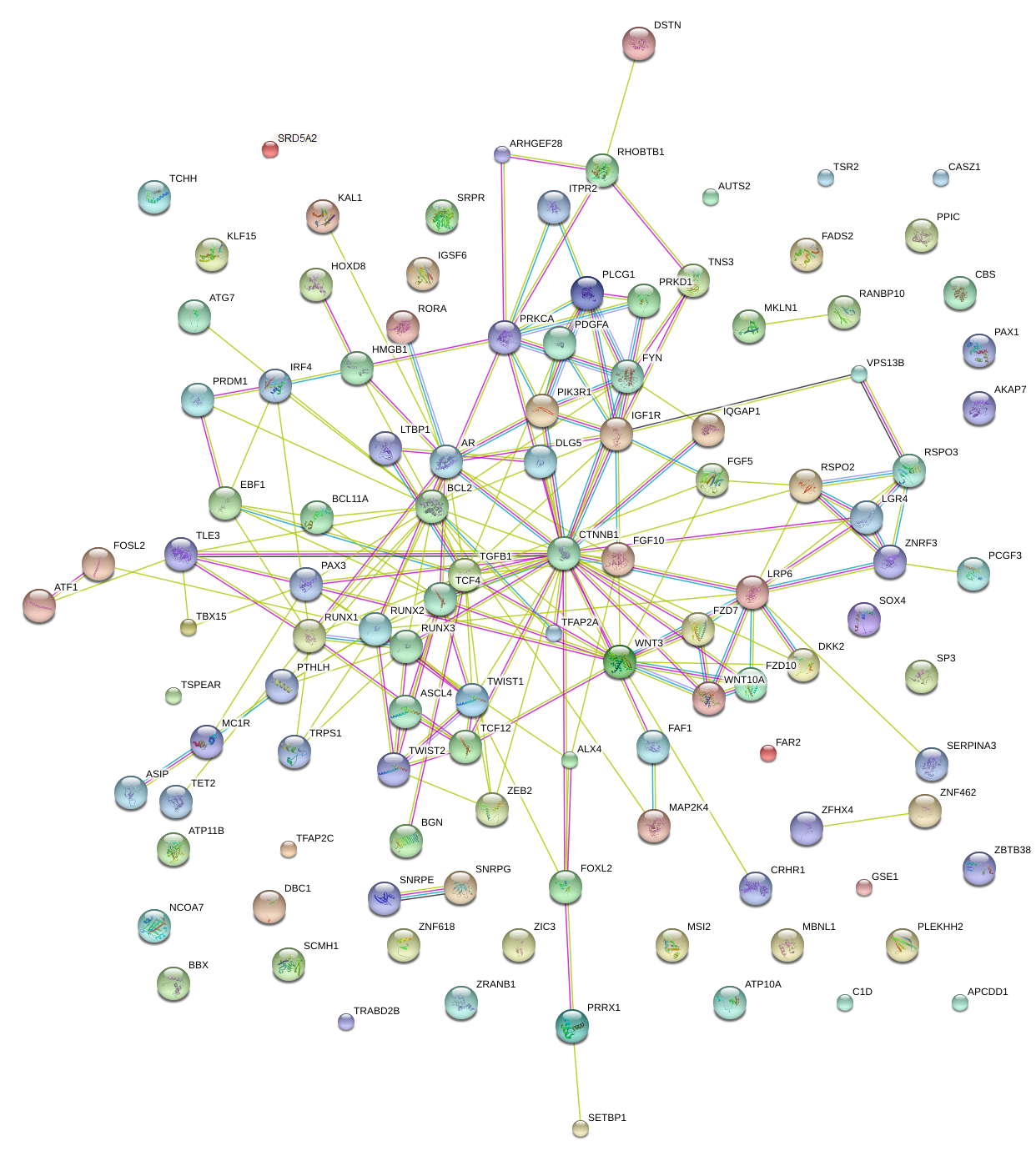
Top 30 enriched Gene Ontology (GO) terms among these genes:
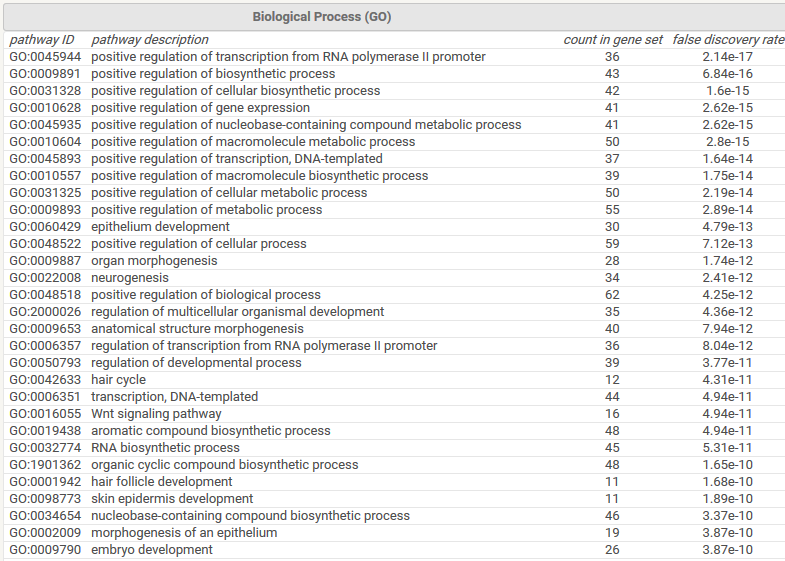
Enriched KEGG pathways among these genes:
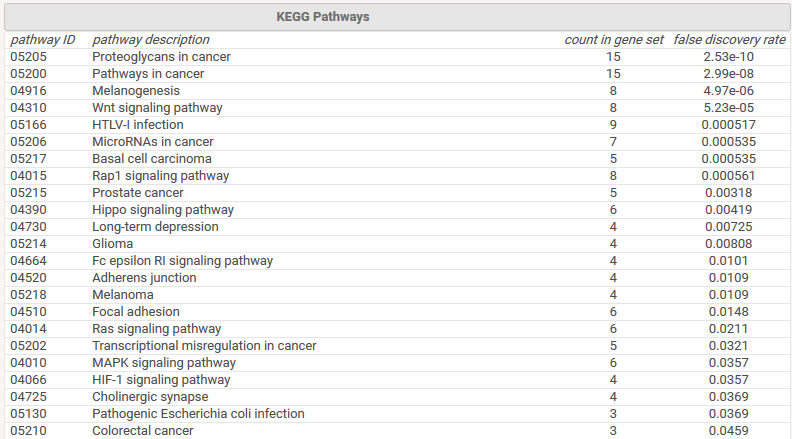
For comparison, here's a similar look at alopecia areata using loci from Petukhova and Christiano:
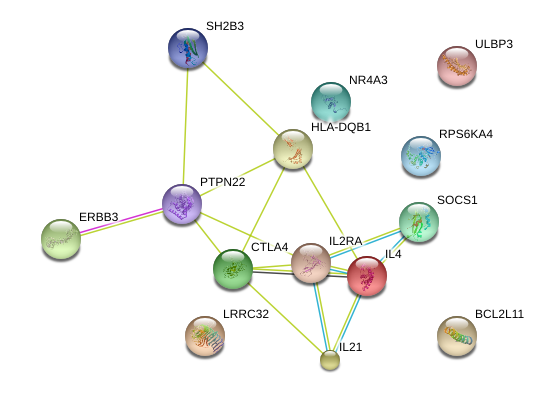
Top 30 enriched Gene Ontology (GO) terms for alopecia areata:
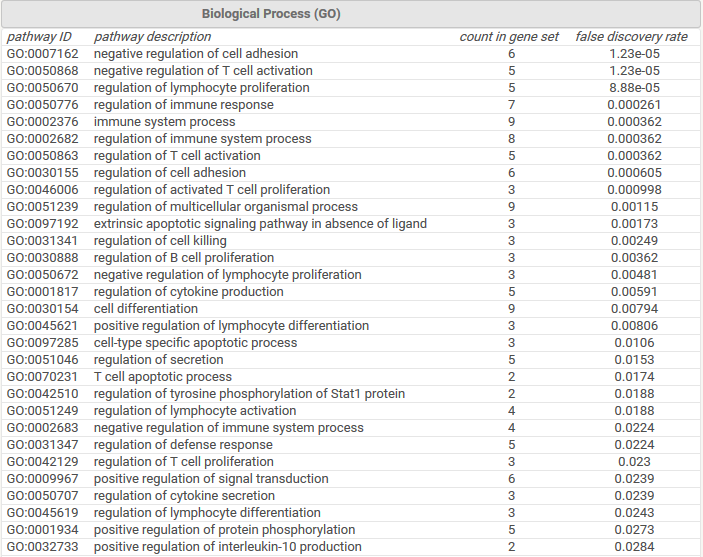
Enriched KEGG pathways for alopecia areata:
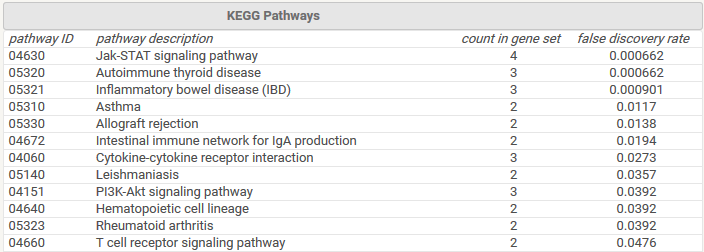
@Swoop
Interesting, thanks! I've attached the full text:
"Wnt target genes such as LGR5...exhibited an inverse relationship."
This isn't unique to A.G.A. Lgr5 is a marker for activated hair follicle stem cells which is also highly downregulated in alopecia areata. Its expression is highest in anagen, so it makes sense that it would be downregulated in A.A as well.
"The mechanism(s) by which intradermal Rspo2 delayed the onset of catagen and lengthened the growth phase of the hair cycle were investigated. Lgr5 marks proliferative stem cells in HFs (Jaks, Barker, 2008) and using Lgr5LacZ/+ mice (Barker et al., 2007) we confirmed the spatial and temporal distribution of Lgr+ve cells, which paralleled exactly the levels of endogenous Wnt signaling, being highest during anagen and lowest during catagen (Fig. 5a-e)."
(Smith et al.)
In A.G.A, perhaps this pathway is more directly compromised? Li et al. found that R-spondin is required to activate expression of Lgr5 in HFSCs -- Wnt alone doesn't cut it.
In Hagenaars et al., the lead SNP near RSPO2 (rs183207557) is a close 2nd in effect size to the lead SNP near AR. In Heilmann-Heimbach et al.'s meta-analysis, the RSPO2 locus was also 2nd only to AR. Another R-spondin, RSPO3, is near an indel that their meta-analysis identified. RSPO3 was also one of the most downregulated genes in balding DPCs in Chew et al.'s microarray study, and was further downregulated by DHT in both balding and non-balding DPCs. R-spondins are DPCs signature genes though, so expression of RSPO3 was pretty low, and they lost expression of RSPO1 and RSPO2 entirely.
"ASIP (agouti signaling protein), encoding another antagonist of the alpha-MSH receptor [MC1R], was found highly expressed in 86% of the A.G.A subjects."
Weird that they found ASIP protein was actually downregulated though. Could that be a result of Corin activity?
"Altogether, these data bring new evidences that distinct altered mechanisms converging to Wnt/beta-catenin signaling account for A.G.A in young male subjects. They also evidence B and T cell involvement suggesting an underlying autoimmune-related mechanism that remains to be further highlighted."
It looks beta-catenin is also a hub gene among A.G.A GWAS hits, at least based on the String-DB diagram.
1) Average distance from the associated SNPs/indels in the region to the gene.
2) Whether the gene has a known role in hair follicle biology.
3) Co-expression of the gene and genes near other A.G.A loci (based on that stem cell transcriptome paper and Rendl's postnatal mouse data).
4) The gene's connectivity to genes near other A.G.A loci (i.e. whether it belongs to pathways/subnetworks containing other A.G.A-associated genes)

Top 30 enriched Gene Ontology (GO) terms among these genes:

Enriched KEGG pathways among these genes:

For comparison, here's a similar look at alopecia areata using loci from Petukhova and Christiano:

Top 30 enriched Gene Ontology (GO) terms for alopecia areata:

Enriched KEGG pathways for alopecia areata:

@Swoop
Interesting, thanks! I've attached the full text:
"Wnt target genes such as LGR5...exhibited an inverse relationship."
This isn't unique to A.G.A. Lgr5 is a marker for activated hair follicle stem cells which is also highly downregulated in alopecia areata. Its expression is highest in anagen, so it makes sense that it would be downregulated in A.A as well.
"The mechanism(s) by which intradermal Rspo2 delayed the onset of catagen and lengthened the growth phase of the hair cycle were investigated. Lgr5 marks proliferative stem cells in HFs (Jaks, Barker, 2008) and using Lgr5LacZ/+ mice (Barker et al., 2007) we confirmed the spatial and temporal distribution of Lgr+ve cells, which paralleled exactly the levels of endogenous Wnt signaling, being highest during anagen and lowest during catagen (Fig. 5a-e)."
(Smith et al.)
In A.G.A, perhaps this pathway is more directly compromised? Li et al. found that R-spondin is required to activate expression of Lgr5 in HFSCs -- Wnt alone doesn't cut it.
In Hagenaars et al., the lead SNP near RSPO2 (rs183207557) is a close 2nd in effect size to the lead SNP near AR. In Heilmann-Heimbach et al.'s meta-analysis, the RSPO2 locus was also 2nd only to AR. Another R-spondin, RSPO3, is near an indel that their meta-analysis identified. RSPO3 was also one of the most downregulated genes in balding DPCs in Chew et al.'s microarray study, and was further downregulated by DHT in both balding and non-balding DPCs. R-spondins are DPCs signature genes though, so expression of RSPO3 was pretty low, and they lost expression of RSPO1 and RSPO2 entirely.
"ASIP (agouti signaling protein), encoding another antagonist of the alpha-MSH receptor [MC1R], was found highly expressed in 86% of the A.G.A subjects."
Weird that they found ASIP protein was actually downregulated though. Could that be a result of Corin activity?
"Altogether, these data bring new evidences that distinct altered mechanisms converging to Wnt/beta-catenin signaling account for A.G.A in young male subjects. They also evidence B and T cell involvement suggesting an underlying autoimmune-related mechanism that remains to be further highlighted."
It looks beta-catenin is also a hub gene among A.G.A GWAS hits, at least based on the String-DB diagram.
Attachments
- Reaction score
- 211
So MBNL1 in ur opinion is the biggest suspect. This research is gold. Why did u stop researching this. Like i honestly feel like u are super close to identifying the issueGenes Potentially Affecting Androgen Metabolism
SRD5A2 – 5-alpha-reductase type II, A.G.A. doesn't happen without it. SRD5A2 expression is higher in DPCs from bald scalp than in non-bald occipital DPCs.

(this is from Moon et al.)
UBIAD1 – Although the most distant of the candidate genes near the Chr1 locus, UBIAD1 (also called TERE1) is interesting because of its effects on androgen metabolism and common loss of expression in castration-resistant prostate cancer. (Fredericks et al., 2013)
^^^ If the same kind of pathway is at work in skin, maybe Vitamin K-2 analogs would be somewhat useful for A.G.A., who knows?
AR Regulation
AR – androgen receptor, A.G.A. doesn't happen without it. AR expression is higher in bald DPCs than in non-bald occipital DPCs.

(this is from Moon et al.)
RANBP10 – known AR coactivator (Harada et al., 2008)
MBNL1 and Myotonic Dystrophy
I came across a reference to a condition called myotonic dystrophy, and curiously enough, premature A.G.A. is very common in these people.
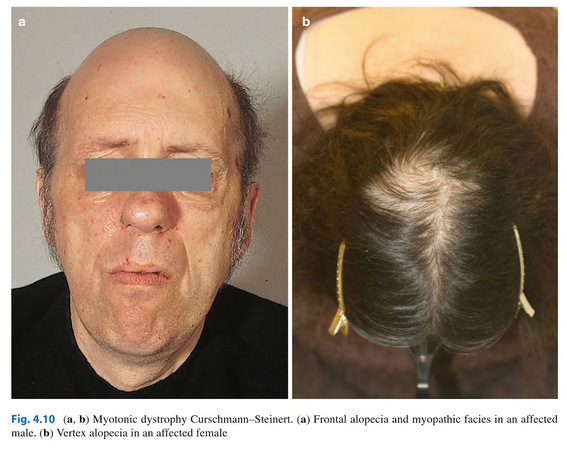
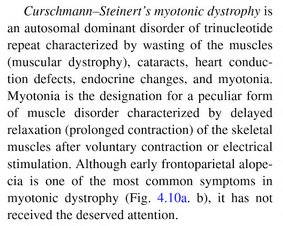
(Ralph Trueb, "The Difficult Hair Loss Patient", pg. 76)
Three cases of androgen-dependent disease associated with myotonic dystrophy:
In myotonic dystrophy type 1 (the more severe form), the RNA-binding protein MBNL1 (musclebind like splicing regulator 1) is sequestered. This loss of function results in inappropriate embryonic-like splice patterns and failure of cells to differentiate properly (Lee and Cooper, 2013). A SNP associated with A.G.A., being about 300kb from the MBNL1, is somewhat distant but still well within the normal range for regulatory elements. Because of the myotonic dystrophy connection, I consider it the most likely candidate.
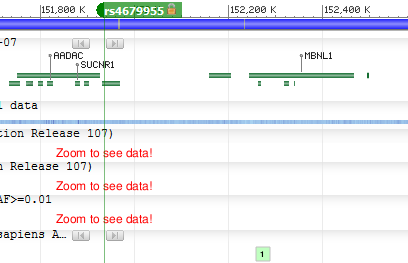
(Davis et al., 2015)
^^^ Genes involved in regulation of development and regulation of cell migration are a common theme in both the GWAS and in a list of genes affected by estrogen – perhaps the most potent reverser of A.G.A. – in hair follicles (again see the dissertation, pg. 108-109). Speaking of which, I put both the GWAS list and the estrogen list from that dissertation into WebGestalt for WikiPathways enrichment. The GWAS list was enriched for 42 pathways at p < 0.05, and the estrogen list for 22 pathways. Of the 22 pathways in the estrogen list, 14 pathways (63.6 percent) were also in the GWAS list. Given there are about 800 pathways in the WikiPathways database, this is quite a significant overlap. I'll admit that the estrogen list itself influenced me to pick FOSL2 for the GWAS list, but only one pathway in the WikiPathways database, "corticotropin-releasing hormone", contains it, and that one does show up in both lists. Anyway, these were the 14 pathways enriched for both the GWAS list and the estrogen list:
Code:Focal Adhesion EGF-EGFR Signaling Pathway Muscle cell TarBase Signaling Pathways in Glioblastoma Corticotropin-releasing hormone Regulation of Actin Cytoskeleton Lymphocyte TarBase TGF Beta Signaling Pathway Endochondral Ossification Androgen receptor signaling pathway DNA damage response (only ATM dependent) Senescence and Autophagy Neural Crest Differentiation MAPK signaling pathway
This myotonic dystrophy thing fascinates me though. It makes me wonder how much alternative splicing of genes involved in development are responsible for A.G.A. TARDBP, the closest characterized gene to that tricky Chr1 locus, is also an RNA splicing factor.
Structural Proteins
TCHH – trichohyalin, a structural protein of the inner root sheath that confers mechanical strength to hair. This is a missense mutation, also associated with straight vs. curly hair (Medland et al., 2009).
SSPN – sarcospan
Other Development-Related Genes
PAX1 – The second most significantly associated gene with A.G.A. after AR, expressed in DPCs. Often a hedgehog target gene involved in patterning of mesenchymal cell lineages. The same haploblock associated with A.G.A. is also associated with nose width (Adhikari et al., 2016) and inversely associated with specifically female idiopathic scoliosis but not with male idiopathic scoliosis (Wise et al. 2015).
PRRX1 – homeobox gene expressed in DPCs
TFAP2A – encodes the transcription factor AP-2alpha. Possibly involved in hair follicle remodeling (Panteleyev et al., 2003)
TRPS1 – DPC signature gene. Loss of function results in trichorhinophalangeal syndrome (TRPS), which includes hair loss. In one Japanese woman with TRPS, Stat3, Sox9, and beta-catenin were highly upregulated (Shibata et al., 2014). Another study (Christiano et al., 2012) showed that Trps1 inhibits Sox9 expression in mice. You could maybe put this in the Twist/Runx category, since Trps1 interacts with Runx2 and inhibits its activity (Lee et al., 2008).
Other References
SRM – Spermidine Promotes Human Hair Growth and Is a Novel Modulator of Human Epithelial Stem Cell Functions
ATG7 – The significant role of autophagy in the granular layer in normal skin differentiation and hair growth
- Reaction score
- 2,038
Why not look for things that increase anagen? How do these different affect peripheral hair growth and beard growth? Thank you from the community for this hard work.I've combined the GWAS results from Hagenaars et al. (including results of their MAGMA analysis) with this recent meta-analysis by Heilmann-Heimbach et al. Altogether, there are around 115 separate genetic regions identified. I've prioritized genes based on:
1) Average distance from the associated SNPs/indels in the region to the gene.
2) Whether the gene has a known role in hair follicle biology.
3) Co-expression of the gene and genes near other A.G.A loci (based on that stem cell transcriptome paper and Rendl's postnatal mouse data).
4) The gene's connectivity to genes near other A.G.A loci (i.e. whether it belongs to pathways/subnetworks containing other A.G.A-associated genes)

Top 30 enriched Gene Ontology (GO) terms among these genes:

Enriched KEGG pathways among these genes:

For comparison, here's a similar look at alopecia areata using loci from Petukhova and Christiano:

Top 30 enriched Gene Ontology (GO) terms for alopecia areata:

Enriched KEGG pathways for alopecia areata:

@Swoop
Interesting, thanks! I've attached the full text:
"Wnt target genes such as LGR5...exhibited an inverse relationship."
This isn't unique to A.G.A. Lgr5 is a marker for activated hair follicle stem cells which is also highly downregulated in alopecia areata. Its expression is highest in anagen, so it makes sense that it would be downregulated in A.A as well.
"The mechanism(s) by which intradermal Rspo2 delayed the onset of catagen and lengthened the growth phase of the hair cycle were investigated. Lgr5 marks proliferative stem cells in HFs (Jaks, Barker, 2008) and using Lgr5LacZ/+ mice (Barker et al., 2007) we confirmed the spatial and temporal distribution of Lgr+ve cells, which paralleled exactly the levels of endogenous Wnt signaling, being highest during anagen and lowest during catagen (Fig. 5a-e)."
(Smith et al.)
In A.G.A, perhaps this pathway is more directly compromised? Li et al. found that R-spondin is required to activate expression of Lgr5 in HFSCs -- Wnt alone doesn't cut it.
In Hagenaars et al., the lead SNP near RSPO2 (rs183207557) is a close 2nd in effect size to the lead SNP near AR. In Heilmann-Heimbach et al.'s meta-analysis, the RSPO2 locus was also 2nd only to AR. Another R-spondin, RSPO3, is near an indel that their meta-analysis identified. RSPO3 was also one of the most downregulated genes in balding DPCs in Chew et al.'s microarray study, and was further downregulated by DHT in both balding and non-balding DPCs. R-spondins are DPCs signature genes though, so expression of RSPO3 was pretty low, and they lost expression of RSPO1 and RSPO2 entirely.
"ASIP (agouti signaling protein), encoding another antagonist of the alpha-MSH receptor [MC1R], was found highly expressed in 86% of the A.G.A subjects."
Weird that they found ASIP protein was actually downregulated though. Could that be a result of Corin activity?
"Altogether, these data bring new evidences that distinct altered mechanisms converging to Wnt/beta-catenin signaling account for A.G.A in young male subjects. They also evidence B and T cell involvement suggesting an underlying autoimmune-related mechanism that remains to be further highlighted."
It looks beta-catenin is also a hub gene among A.G.A GWAS hits, at least based on the String-DB diagram.
